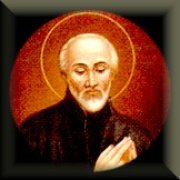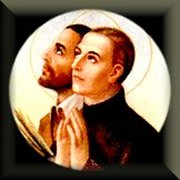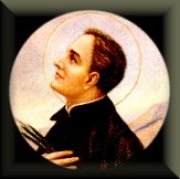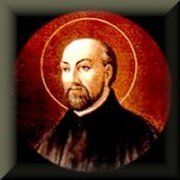North American Martyrs
![]()
![19kb jpg holy card image of the North American Martyrs, artist unknown; please do not write to ask about the image [North American Martyrs holy card]](martyr07.jpg)
North American Martyrs:
Antonie Daniel, Charles Garnier, Isaac Joques, John de Brebeuf
Gabriel Lalemant, John de la Lande, Neol Chabanel, & Rene Goupil
"My confidence is placed in God
who does not need our help for accomplishing his designs. Our single endeavor
should be to give ourselves to the work and to be faithful to him, and not to
spoil his work by our shortcomings. "
-Saint Isaac Jogues
|
Born in France; died 1642-1649;
canonized in 1930 by Pope Pius XI These martyrs probably mean nothing to our European friends, but they were among the earliest saints of North America. All were French born Jesuits: Jean de Brébeuf, Isaac Jogues, Antony Daniel, Gabriel Lalemant, Charles Garnier, and Noel Chabanel, priests; and John Lalande and René Goupil, lay-brothers. They selflessly worked among the native Hurons until they met their death at the hands of mortal enemies of the Hurons: the Iroquois and the Mohawks. The Iroquois were animated by the bitter hatred of the missionaries, whom they subjected to indescribable tortures before putting them to death. René (Renatus) Goupil (1606 to September 29, 1642) was born at Anjou, France. Amazingly, ill health forced him to leave the Jesuits, yet he was willing and able to accompany the missionaries after he had become a successful surgeon. In 1638, he went to Quebec to work among the Jesuit missions as an attaché to the hospital in Quebec. He became a lay assistant for the mission to the Hurons in 1640. While on a journey with Isaac Jogues in 1642, he was captured by a group of Iroquois and tomahawked to death on September 29 at Osserneon near Albany, New York, for making the sign of the cross on the brow of some children. He was the North American protomartyr. |
||
 |
Isaac Jogues (Born at Orléans, France, on January 1, 1607; died October 18, 1646) was the son of wealthy parents. He studied at the Jesuit school in his home town and entered the Society of Jesus at Rouen in 1624. He continued his education at Le Flèche. After his ordination in 1636, he requested and received permission to work as a missionary in Quebec, Canada. He took the Gospel to the Mohawks and in the course of his labors penetrated to the eastern entrance of Lake Superior, one thousand miles inland--the first European to do so. | |
|
Fr. Jogues' plan to preach the Gospel
to the Sioux Indians in the region of the Mississippi headwaters came to an
end when he was captured, together with René Goupil and other Jesuits, by an
Iroquois war party on October 3, 1642. They had just completed a mission of
mercy to the Hurons, who were suffering from famine and disease, when they
were ambushed by the enemies of the Hurons. Saint René was killed. The rest
were held for 13 months in slavery and so cruelly tortured that Father
Jogues lost the use of his hands. (Pope Urban VIII permitted him to say Mass
despite this deformity. This was a unique dispensation in the history of the
Church. The holy father observed, "It would be unfitting to refuse
permission to drink the blood of Jesus Christ to one who has testified to
Christ with his blood.")
The Dutch Calvinists from Fort Orange (Albany, New York) negotiated continuously for his release. When he was about to be slowly roasted to death they helped him to escape to New York--thus, he became the first Catholic priest to come to that state. From New Amsterdam (as New York was then called), he travelled by small ship to England, arriving there on Christmas Day completely destitute. He finally reached France, where the Queen Mother received him with extreme deference, but in 1644 he requested to be allowed to return to Quebec. Less than three years after his captivity, he set out with Jean de Lalande for his place of imprisonment (Osserneon, now Auriesville, NY), this time as a missionary to the Iroquis with whom a peace treaty had been signed. During this second visit, Father Isaac left behind a box of religious objects. These were wrongly believed to be the cause of an epidemic and a crop failure that occurred soon after his departure. On his third visit, a member of the Mohawk Bear clan, believing him to be a sorcerer, blamed him for the suffering of his people. One afternoon the Mohawk invited Jogues for a meal. The priest was seized, together with the Jesuit lay-brother, Saint John Lalande. The other missionaries with them had fled at that change of attitude they sensed among the natives. Jogues and Lalande were beaten and slashed with knives and that evening Isaac Jogues was tomahawked. The next day Lalande was killed in the same way. Their heads were struck off and impaled on the settlement palisade, and their trunks thrown into the Mohawk River about 40 miles west of Albany, NY, near Midland, Ontario. There is a portrait of Father Isaac that was painted in 1644 during his visit to France. In it you can see that only the middle and ring fingers remain of his right hand. He is a slender, white- haired man with a very long and flaring nose, deep-set eyes, curly hair, beard, and mustache. After his death, the fatal tom ahawk wound was added. |
||
| John de Lalande (Born at Dieppe, France; died 1646) travelled to Quebec to become a donné (lay assistant) to the Jesuit missionaries. In 1646, he accompanied Isaac Jogues on a trip to the territory of the Iroquois after a peace treaty with them had just been signed. They were captured by a war party of Mohawks. John was tomahawked and beheaded at Osserneon near Albany, on October 19, the day after Fr. Jogues had suffered a similar fate there. |
 |
|
 |
Antony Daniel (Born at Dieppe, France, on March 27, 1601; died July 4, 1648) studied law but abandoned it to join the Jesuits at Rouen in 1621. He taught in Rouen for four years, studied theology at Clermont, was ordained in 1630, and was then assigned to the college at Eu. With three other priests he was sent as a missionary to Cape Breton Island, Arcadia, New France (Canada), in 1632. A year later Fr. Daniel went to Quebec. He was successful in his missionary work among the Hurons, even founding a school for Native American boys at Quebec in 1636. In 1648, Fr. Daniel was martyred by a party of Iroquois at the Indian village of Teanaustaye near Hillsdale, Ontario. | |
| Charles Garnier (Born at Paris, France, c. 1605; died 1649), son of the treasurer of Normandy, was educated at Louis-le-Grand College and joined the Jesuits in Paris in 1624. He continued his studies at Clermont, taught at the Jesuit college at Eu for three years, and was ordained in 1635. The following year he was sent to Quebec, Canada, with Father Pierre Chastellain and two other priests as missionaries to the Hurons. Charles was murdered by a war party of Iroquois on December 7, 1949, at the Indian village of Etarita, where he was stationed. |

|
|
|
|
Noel Chabanel (Born near Mende, France, on February 2, 1613; died December 8, 1649), after joining the Jesuits in 1630, was sent to New France in 1643 to evangelize the Hurons. He became assistant to Fr. Garnier at Etarita in 1649 and was murdered by an apostate Indian while returning from a visit to neighboring Sainte Marie. | |
| John de Brébeuf (Born at Condé-sur-Vire, Normandy, France, on March 25, 1593; died March 16, 1649) was the son of farmers. He attended the university at nearby Caen and worked on his parent's farm before joining the Jesuits at Rouen in 1617. Although he was almost forced to leave the society when he contracted tuberculosis and was so affected that he could neither study or teach for the customary periods, he was ordained in 1622. It is remarkable, therefore, that in 1625 he requested to be sent to Canada as a missionary. There, despite opposition from the Protestant Huguenots, trading company officials, and renegade Indians, Father de Brébeuf labored among the Hurons for the next 24 years--but not without interruption. |
 |
|
|
In 1629, when the English captured
Quebec, he was ousted with other Jesuits and forced to return to France. For
a time Fr. Brébeuf was treasurer at the Jesuit college in Eu until the
English returned Canada to the French in 1633. At that time he went back
into the mission field. From this time until his death, his evangelizing
efforts were richly rewarded.
At the request of the Hurons, Father de Brébeuf lived among them, sometimes with companions, and sometimes alone. He preached and catechized in their own language. But his work had to overcome superstition, violence, cannibalism, and the fact that he belonged to an alien, conquering race. He founded schools and baptized over 200 neophytes in one year. When smallpox killed thousands of Indians in 1637, the missionaries were blamed by the tribal medicine men for the disaster. Brébeuf was condemned to death, but spoke so eloquently of the after-life that he was given a reprieve. He stayed with the Indians until 1640, when he went to Quebec for four years. Then returned to the Indians. |
||
| He was captured together with Gabriel Lalemant by Iroquois, enemies of the Hurons, on March 16 at Sainte-Marie, near Georgian Bay, and was cruelly tortured for hours, mutilated, burned to death, and finally eaten. Known for his holiness and courage, he was responsible for some 7,000 conversions among the Indians, and composed a dictionary and catechism in Huron. |
 |
|
|
|
Gabriel Lalement (Born at Paris, France, 1610; died 1649) joined the Jesuits in 1630. He taught at Moulins for three years, and after further study at Bourges, was ordained in 1638. After teaching at La Flèche and Moulins, he was sent to Canada at his request in 1646 as a missionary. | |
| He, too, worked among the Hurons, became assistant to Saint John de Brébeuf at Saint Ignace in 1649, and was with him in the village when the Iroquois attacked and destroyed it on March 16, killing all the inhabitants except the two priests. After torturing them, the Iroquois tomahawked them to death the next day (Attwater, Benedictines, Delaney, Farmer, Melady, Parkman, Schamoni, Wynne). | ||
St. Isaac Jogues and Companions
from the Roman
Breviary
Prayer to the North American Martyrs
O Almighty God, by whose grace and power thy holy martyrs Antony Daniel, Charles Garnier, Gabriel Lalemant, Isaac Jogues, John de Brebeuf, John Lalande, Noel Chabanel, and Rene Goupil triumphed over suffering and were faithful even unto death: Grant us, who now remember them with thanksgiving, to be so faithful in our witness to thee in this world, that we may receive with them the crown of life; through Jesus Christ our Lord, who liveth and reigneth with thee and the Holy Spirit, one God, for ever and ever.
Litany of the Jesuit Martyr Saints of North America
Lord, have mercy on us.
Christ, have mercy on us.
Lord, have mercy on us. Christ, hear us.
Christ, graciously hear us.
God the Father of Heaven,
Have mercy on us.
God the Son, Redeemer of the world,
Have mercy on us.
God the Holy Ghost,
Have mercy on us.
Holy Trinity, one God,
Have mercy on us.
Holy Mary, Mother of God, Pray for us. *
Holy Mary, Queen of Martyrs,*
Saint Isaac Jogues,*
Saint John de Brebeuf,*
Saint Gabriel Lalemant,*
Saint Anthony Daniel,*
Saint Charles Gamier,*
Saint Noel Chabanel,*
Saint Rene Goupil,*
Saint John de la Lande,*
Pioneers of the Cross in a new world,*
Heroic apostles of the faith,*
Zealous promoters of God's glory,*
Consumed with love for souls,*
Men of prayer and action,*
Lovers of poverty,*
Models of chastity,*
Faithful in obedience,*
Followers of Christ Crucified,*
Fearless in suffering for Christ,*
Enduring cold and hunger for Christ,*
Stripped and scourged for Christ,*
Tortured by fire for Christ,*
Cruelly slain for Christ,*
Peerless athletes of God,*
Loving children of the Queen of Martyrs,*
Filial clients of St. Joseph,*
Worthy sons of St. Ignatius,*
Our intercessors in Heaven*
Lamb of God, Who takest away the sins of the world:
Spare us, O Lord
Lamb of God, Who takest away the sins of the world:
Graciously hear us, O Lord.
Lamb of God, Who takest away the sins of the world:
Have mercy on us.
Let us pray:O God, Who hast hallowed the first-fruits of the faith in the northern regions of America by the preaching and blood of Thy blessed Martyrs John, Isaac and their companions: grant in Thy mercy, that through their intercession the plentiful harvest of the faithful may increase everywhere from day to day. Through Our Lord Jesus Christ Thy Son, Who liveth and reigneth with Thee in the unity of the Holy Ghost, one God, world without end. Amen.